
MPC integrated hybrid and full-CG characters into live action footage to bring a graphic novelist’s story to life on board a commuter train.
MPC Powers Inspiration behind an Alternate Universe for Dell |
|
MPC created, animated and integrated hybrid and full-CG characters into live action footage to bring a graphic novelist’s story to life on board a commuter train. The script for the spot concerns main character Thomas, who commutes to work on the train and recognizes the same faces around him, day to day. He uses those faces as inspiration for a graphic novel populated with anthropomorphic characters, which we watch him creating on his Dell laptop during his daily commute. The CG creatures were to be an immersive extension of the story he was creating, and bring it to life. Preparing to ShootMPC had artists in multiple locations working on the project - New York, LA, London and Bangalore. MPC NY’s VFX supervisor and CG lead Bill Dorais spent seven days in Bucharest, Romania helping prepare costumes, set up the product shoot, design head rigs for tracking, and assisted with the tech scout. |
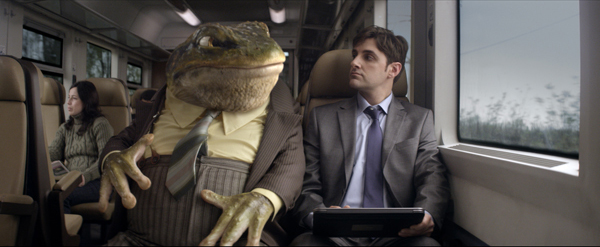 |
|
The shoot in Bucharest involved three days on a train, shot both moving and static. The majority of the shoot was hand held. After returning to the studio, Bill began re-creating the train set from measurements and photographs. Once the edit had been cut, the team requested plates, organized them into 3D, 2D and clean-up shots, and 3D shots were prepped with lens information and the camera tracking and object tracking set-up. The 3D creation of the characters proceeded simultaneously. Working with director Bjoern Ruehmann from the project’s production company Furlined, MPC designed and created all of the characters and all of the drawings in the graphic novel. “We were given a brief about each one of the characters, which we used for our sketches and designs,” said Bill Dorais. “Bjoern had a real vision of what he wanted and we did everything we could to bring that vision to fruition. “We went back and forth on everything from the characters’ head size, to the colour, to slimness, furriness, fabric colour and dimensions of the wardrobe. Then we sketched the characters out before the final casting had been completed. Based on our designs, they cast a short man as the toad character because we knew he was going to have an oversized head and we didn't want him to be too big or tall compared to Thomas.” Personality PlusWhen developing and designing the anthropomorphic characters, MPC also took special care to define their personalities to give them vitality and a connection to the real world. By designing and expressing detailed personality traits, the audience wants to learn more about each of them. |
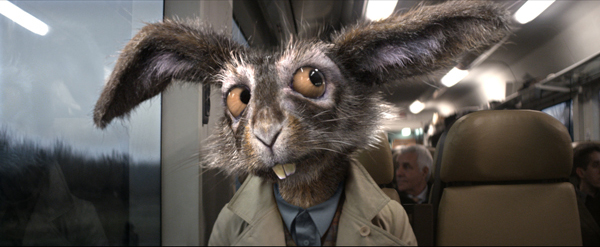 |
|
For example, the toad is grumpy and irritable. VFX supervisor Gigi Ng said, “We tried to accentuate this with his mouth line by making it more prominent, but with a subtle frown. We also emphasized how his eyes furrow and are never really open wide. He’s never curious, but always suspicious. By contrast, the rabbit character is always wide-eyed and alert.” During the live action shoot, actors wearing full costumes and specialised headgear took the parts of the anthropomorphic toad, rabbit and bird on set with Thomas and the ‘regular’ train passengers. MPC was to replace the actors’ live action heads with CG heads, and prosthetics were used for their hands. Customised Headgear“The headgear used was designed to help us with multiple tasks,” said Bill. “White balls extending from the actor’s head were used to represent the positions of the characters’ eyes and snouts. As the CG heads were going to be oversized, it was helpful on set for everybody to imagine the head sizes and predict eye lines. In post we used the helmets to capture the actors’ head movements. The white values of the balls were used to help us determine the diffuse levels of our CG lights. |
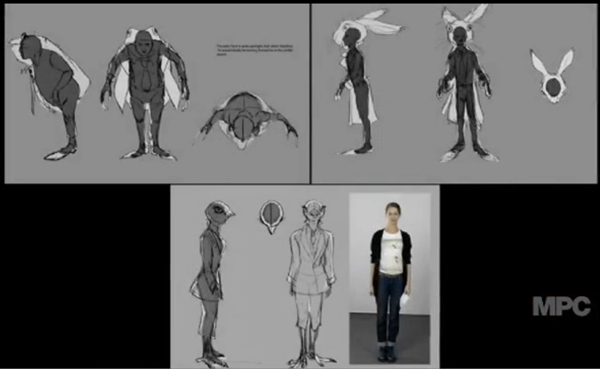 |
|
“The helmets themselves were designed in house at MPC with our 3D software. We then sent out the plans toFilmefexin Budapest to create the devices, and members from Filmefex flew in for the shoot to make sure everything went smoothly. These head rigs were really our lifelines in post - without them the process would have been impossible.” Another priority was researching the creature anatomy to capture a perfect, believable look. Bill said, “For the toad we were trying to get the blinks to look correct, giving him a nictitating membrane, a thin skin that covers the eye. Our philosophy going into this project was that the more details we added, the more believable the piece would be.” |
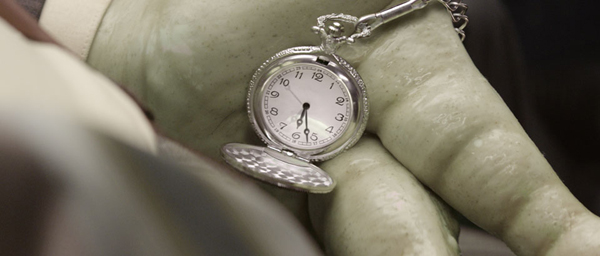 |
Animating IterationsBill said, “Our process was to quickly animate various iterations of the animation and render quick and dirty greyscale renders for all of the shots. Each shot went through dozens of iterations before it was finalized. The CG rigs for the characters had dozens of controls, so we really explored quite a bit before narrowing down on a specific look and feel to the animation. The edit had a lot of really quick shots so we had to make each frame count. “Our bird, for example, was in the commercial for about a second but we still went through countless animation iterations, only to end up at a very simple looking animation. During the animation process we also focused on developing the lighting and shading of the toad and rabbit in a single shot. Once we had the lighting down in those key shots, we spread the settings - shadows and lighting - to the remaining shots and began rendering.” |
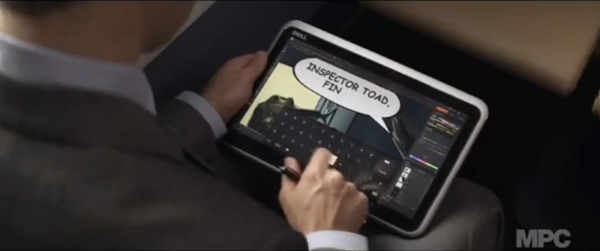 |
|
A few important tasks had to be done on set to help with the CG integration. The first was designing and building the head rigs mentioned earlier to help capture the actors’ movements. They also placed several tracking markers throughout the train to give the tracking software more points to analyze and track the camera movement. Because nearly all the shots were handheld, prepping the train for tracking was very important. “We then took a survey of the train, taking several measurements, and rebuilt it in 3D so we could later create a virtual set. We also took several HDRI images to capture the ambient lighting within the cab,” said Bill. Perfecting Integration“With the virtual camera, we were able to fairly accurately mimic the set and lighting from shot to shot without too much guess work. The prosthetic limbs turned out to be really helpful with the CG texturing and lighting. Having real materials to match in the shot was a great help in making the characters more realistic. Also, MPC has their proprietary software Furtility to create photorealistic hair, fur, feathers and other creature details, which helped integrate the characters with the live action footage. “Our main integration obstacle was getting the neckline of the actors to match up and interact with the animated movement. In the composite our Nuke artists animated and warped the neckline to help with seamless interaction. For example, when the toad turns his head quickly we wanted the collar to mimic this movement. While it's not very noticeable, a significant amount of work went into animating and shaping the collar to look just right.” |
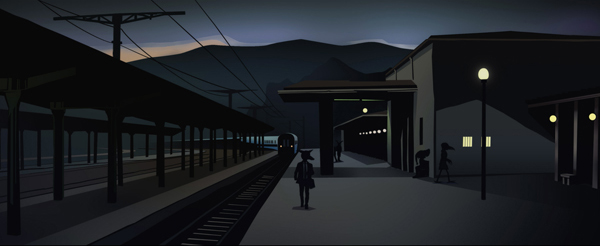 |
|
The CG grasshoppers and their mouse riders that Thomas watches through the window cantering out in the countryside alongside the train were the only all CG creatures in the spot, and caused some interesting challenges. The main one was building a six-legged grasshopper that could canter like a horse. While there are plenty of videos of horses running – evocatively set to cheesy music on YouTube – for reference, looking cricket reference wasn’t very helpful simply because the creatures needed to move like horses. Grasshoppers - Exercise in ZenBill described this as a two-part problem. “First, a grasshopper has two more legs than a horse and second, a grasshopper's body proportions are much different. Most quadrupeds' legs are similar in size to each other but a grasshopper's rear legs are more than twice as long as the front legs. We made it work by treating the front two sets of legs as one and then fine tuning the gait and speed to maintain the key poses without stretching or slipping. |
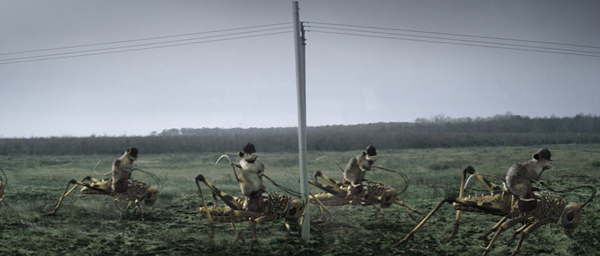 |
|
“The shot has five crickets and five mice in it - any unsimulated crowd shot is always an uphill battle. Artistic and technical challenges are compounded as the interactive speed of the tool slows to a crawl with renders like this. It was definitely an exercise in Zen. Also, one of the big rigging hurdles was to create a set-up that let us blend the grasshoppers' rigid antennae to the looseness you would expect from reins and have it still look great in slow motion. In the case of the grasshoppers, no existing element existed in the plates to relate their CG work to, as there had been for the hybrid characters, making integration and lighting a different sort of exercise. The team went out into the field and captured HDRI imagery and several grass plates. “The plate was flatly lit which always makes the 3D lighting process difficult,” Bill explained. “VFX supervisor Gigi Ng cheated a bit of directional light to the plate by highlighting the sides of the light posts and adding fake shadows, which helped us justify, giving the characters shape with the lighting. It was decided that the shot would have more impact if it were in slow motion. We didn't end up slowing down the footage, but instead we stabilized it by giving it a smooth dreamy feeling and animated the mice and crickets more slowly. Gigi added practical dust elements from our library and then added a window reflection on top to make it feel like the crickets were outside.” www.moving-picture.com CREDITS VFX: MPC Words: Adriene Hurst |


















